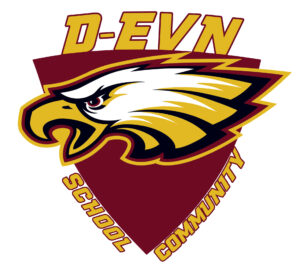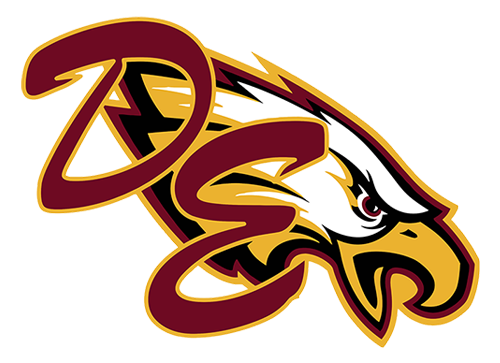How do we produce the videos for D-EVN?
With the equipment that we have (and since 2021-2022, the automated Pixellot cameras are a part of that equipment!), and the software and webspace from the NFHS Network (see “About the NFHS Network” link to the left for more information about that organization), the process is actually pretty easy!
In a nutshell, the sound from our announcers connects either into the Pixellot Camera system, or – when needed – into a camera’s microphone. With the Pixellot Camera systems, the audio is incorporated into the livestream broadcast that the Pixellot cameras help to automate, and then can be viewed on the NFHS Website (specifically https://www.nfhsnetwork.com/schools/dovereyota-high-school-eyota-mn). In situations when a camera is needed, the camera set-up sends its sound and video to the computer, the computer then uses software from the NFHS Network, coupled with the computer’s network connection, to stream the video out to Dover-Eyota’s NFHS webpage (same link: https://www.nfhsnetwork.com/schools/dovereyota-high-school-eyota-mn).
Most events we can stream live, others we have to provide as a “tape-delay” depending on factors such as network availability at an event, and rules regarding broadcasts of High School games and events. Most can stay posted for “on-demand” viewing nearly indefinitely, although some – for various reasons – have to be pulled after a certain amount of time so they can no longer be viewed.
The connections are pretty straightforward and the process for setting things up is also quite simple. That means that volunteers don’t need to know all the ins and outs of broadcast technology. They can do some simple steps, and then they can concentrate on the fun parts like announcing (in most cases, only announcers are needed, and all they need to do is make sure an audio mixer is turned on, put on the headsets and start announcing!), running the camera or handling the graphics!
Once a production reaches its end, there are just a couple of simple steps. When the Pixellot cameras are used, there’s not much that has to be done at all (and for productions where a camera operator is needed, the how to instructions are available at this link!) to finalize the production for on-demand online viewing, and that’s it! Another game production is complete!
Now that you know how easy it is, come and be a part of the D-EVN crew! We need you! See the “Help D-EVN” area, or contact Bryan Berg at bryanberg@deschools.org! It would be great to have you be a part of the D-EVN crew!

With the equipment that we have (and since 2021-2022, the automated Pixellot cameras are a part of that equipment!), and the software and webspace from the NFHS Network (see “About the NFHS Network” link to the left for more information about that organization), the process is actually pretty easy!
In a nutshell, the sound from our announcers connects either into the Pixellot Camera system, or – when needed – into a camera’s microphone. With the Pixellot Camera systems, the audio is incorporated into the livestream broadcast that the Pixellot cameras help to automate, and then can be viewed on the NFHS Website (specifically https://www.nfhsnetwork.com/schools/dovereyota-high-school-eyota-mn). In situations when a camera is needed, the camera set-up sends its sound and video to the computer, the computer then uses software from the NFHS Network, coupled with the computer’s network connection, to stream the video out to Dover-Eyota’s NFHS webpage (same link: https://www.nfhsnetwork.com/schools/dovereyota-high-school-eyota-mn).
Most events we can stream live, others we have to provide as a “tape-delay” depending on factors such as network availability at an event, and rules regarding broadcasts of High School games and events. Most can stay posted for “on-demand” viewing nearly indefinitely, although some – for various reasons – have to be pulled after a certain amount of time so they can no longer be viewed.
The connections are pretty straightforward and the process for setting things up is also quite simple. That means that volunteers don’t need to know all the ins and outs of broadcast technology. They can do some simple steps, and then they can concentrate on the fun parts like announcing (in most cases, only announcers are needed, and all they need to do is make sure an audio mixer is turned on, put on the headsets and start announcing!), running the camera or handling the graphics!
Once a production reaches its end, there are just a couple of simple steps. When the Pixellot cameras are used, there’s not much that has to be done at all (and for productions where a camera operator is needed, the how to instructions are available at this link!) to finalize the production for on-demand online viewing, and that’s it! Another game production is complete!
Now that you know how easy it is, come and be a part of the D-EVN crew! We need you! See the “Help D-EVN” area, or contact Bryan Berg at bryanberg@deschools.org! It would be great to have you be a part of the D-EVN crew!


